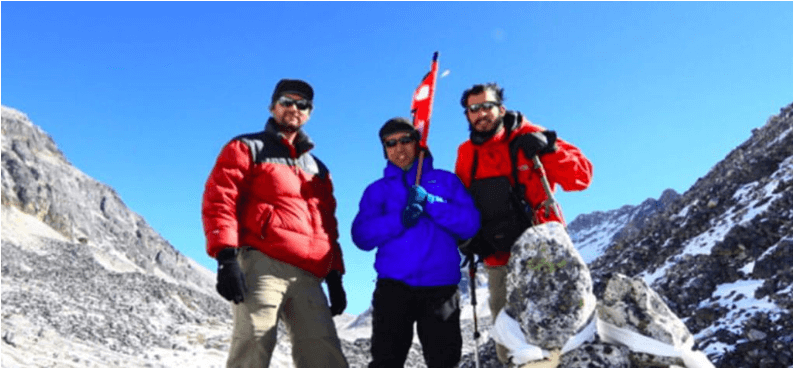
The Great Himalayan Trail atly described as “One trail to rule them all” traverses Nepal’s entire mid-hills and the lower mountains.
The 1700km/120 days long trek by two of Nepal’s favorite sons in search of solutions for the Himalayan Communities by drawing attraction of Global Celebrities and Media to Climate Change in the Himalayas.
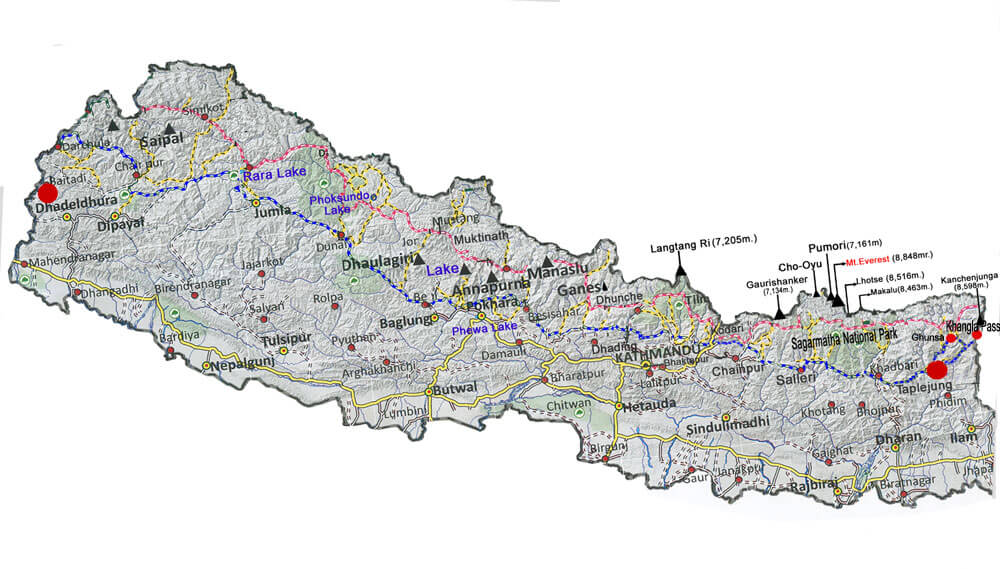
The trek is organized to highlight the impacts of climate change in the Himalayas and to promote The Great Himalaya Trail as the best tourism trail in the world which offers trekkers to experience extremely rich cultures, breathtaking landscapes and diverse range of flora and fauna.
Apa Sherpa (21 times Mt. Everest summiteer) and my son Dawa Steven Sherpa (Two times Mt. Everest summiteer and Managing Director of Asian Trekking (P) Ltd embarked on 1,700 KM and 120 days long Great Himalaya Trail on 15thJanuary, 2012. The event has been endorsed by Climate Change Council, the apex body of Government of Nepal headed by Rt. Hon. Prime Minister. The mountaineer duo will be accompanied by Saurav Dhakal- BCICC, Samir Jung Thapa-the official photographer of the event and guides, cooks, camp staffs and porters from Asian Trekking (P). Ltd.
GHT-CSCT is organized by the Himalayan Climate Initiative (HCI) in coordination with Government of Nepal, particularly Ministry of Environment, and Ministry of Tourism and Civil Aviation, with the support of DFID, British Council, SNV, GHTDP Partners. The event has already received support of Corporate partners Geo-Eye, Asian Trekking (P). Ltd., The North Face, Nepal Mountaineering Association(NMA) and expects to earn the support of several Corporate Partners in the days to come.
Wednesday, 25 April 2012:
Press Conference at Summit Hotel.
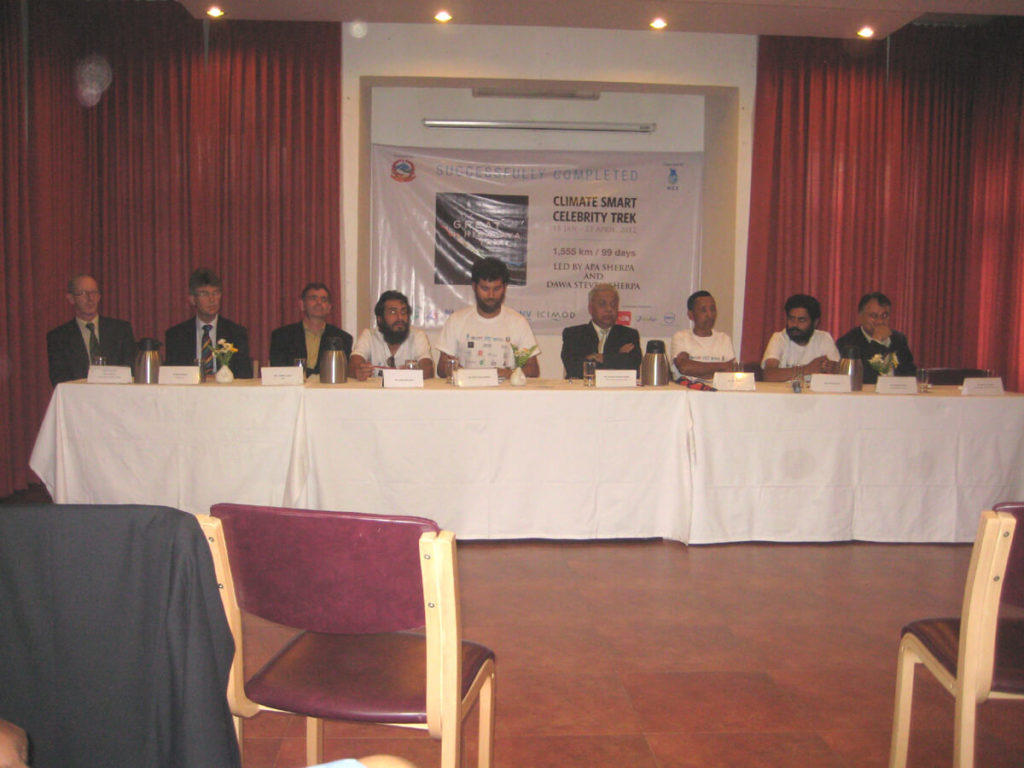
Tuesday, 24 April 2012:
Meeting with Right Honorable President of Nepal Dr. Ram Baran Yadav at President’s Palace.

Day 100, Monday 23rd April 2012:
Kathmandu -Apa, Dawa Steven and GHT-CSCT team are scheduled to meet Rt.Hon’ble President of Nepal Dr Ram Baran Yadav on 23rd April .
Day 99, Sunday 22nd April 2012:
Fly from Dhanghadi to Kathmand and arrive Kathmandu Airport at 3:30 pm.
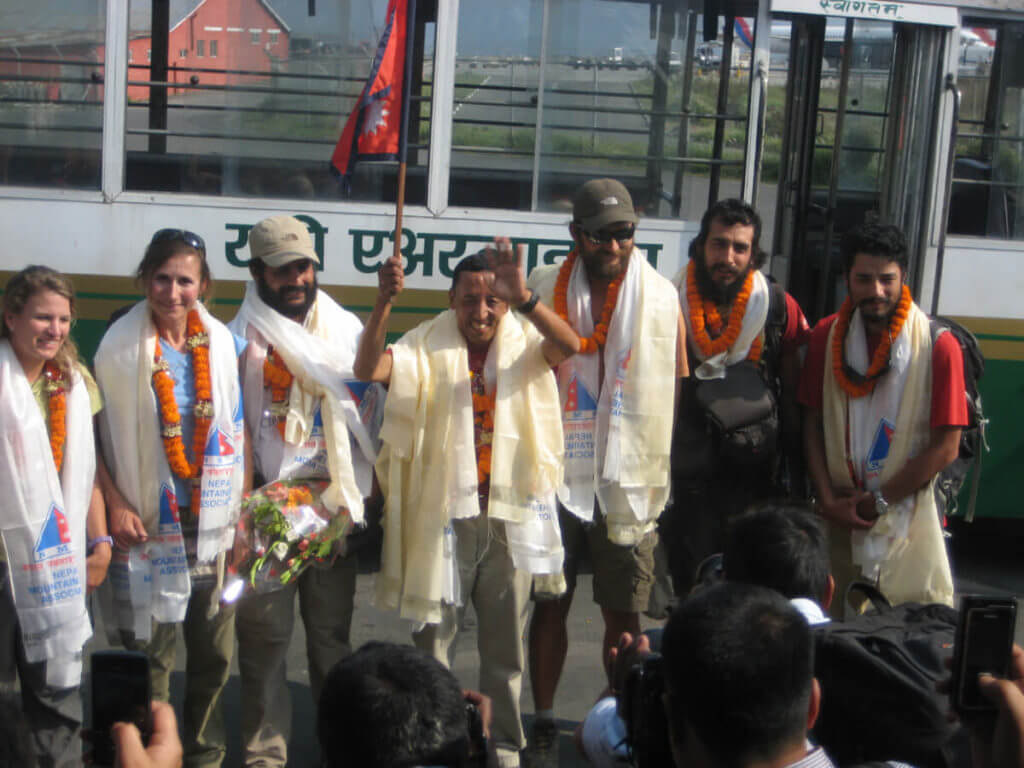
Day 98, Saturday 21st April 2012:
Drive from Khalanga (West Nepal Border with India), Darchula Headquarter to Dhanghadi.
Day 97, Friday 20th April 2012:
Trek from Shiddhi Mandir to Khalanga (West Nepal Border with India), Darchula Headquarter and final distination of GHT-CSCT.
Hearty Congratulations to Apa Sherpa, Dawa Steven Sherpa, Samir Jung Thapa, Saurav Dakal, Linda , Elizabeth, Paribesh Pradhan and all support staffs of the Great Himalayan Trail-Climate Smart Celebrity Trek team for successfuly completing the Great Himalayan Trail.
Record-setting Everest summiteer Apa Sherpa and his team have successfully completed the treacherous Great Himalaya Trail (GHT) walk dubbed as Climate Start Celebrity Trek.
The team reached Khalanga of Darchula, the last destination of the 1,700 km trek, on April 20, 23 days ahead of the schedule. The team finished the walk ahead of the schedule because they had to use an alternative trail to Khalanga due to massive snowfall on alpine routes in Bajhang, Bajura and Darchula, according to Prashant Singh of Himalayan Climate Initiative that organized the walk.
Apa and his team had started the walk from Taplejung district three months ago. According to Singh, Apa will organize a press meet in Khalanga before departing to Kathmandu via Dhangadhi. He is scheduled to meet President Dr Ram Sharan Mahat on April 23.
Climate Smart Celebrity Trek was organized to draw the attention of the world community toward the impact of climate change and global warming in the Himalayas.
Day 96, Thursday 19th April 2012: Trek from Sela Gaon to Shiddhi Mandir
Day 95, Wednesday 18th April 2012: Trek from Lathinath to Sela Gaon
Day 94, Tuesday day 17th April 2012: Trek from Jathagaon to Lathinath
Day 93, Monday 16th April 2012: Trek from Chainpur, Bajang District Headqaurter to Jathagaon
Day 92, Sunday 15th April 2012: Trek from Tutigaon to Chainpur, Bajang District Headqaurter.
Day 91, Saterday 14th April 2012: Trek from Kotgaon to Tutigaon
Day 90, Friday 13th April 2012: Trek from Martadhi, Bajura District Headquarter to Kotgaon.
Day 89, Thursday 12th April 2012: Trek from Kolti to Martadhi, Bajura District Headquarter.
Day 88, Wednesday 11th April 2012: Trek from Ratopani to Kolti
Day 87, Tuesday 10th April 2012: Trek from Rara Lake to Ratopani
Day 86, Monday 9th April 2012: Trek from Jyare to Rara Lake – Press meet
Day 85, Sunday 8th April 2012: Trek from Naulighat to Jyare
Day 84, Saturday 7th April 2012: Trek from Jumla to Naulighat
Day 83, Friday 6th April 2012: Trek from Manigaon to Jumla (Khalanga Bazar)-Press Meet
Day 82, Thurdsday 5th April 2012: Trek from Kaigaon to Manigaon
Day 81, Wednesday 4th April 2012: Trek from Likhu to Kaigaon
Day 80, Tuesday·3rd April 2012: Trek from Kageni to Likhu
Day 79, Monday 2nd April 2012: Trek from Ringmo to Kageni
Day 78, Sunday 1st April 2012: Ringmo – Exploring around Phoksundo Lake.
Day 77, Saturday 31st March 2012: Trek from Sepka to Ringmo
Day 76, Friday 30th March 2012: : Trek from Dunai to Chepka
Press meet at Dunai:
On the 75thday of Climate Smart Celebrity Trek, Apa Sherpa and his team reached and interacted with the local people and the media in Dunai. The team received a huge welcome there, accompanied by a rally and traditional music that went around Dunai. The press meet was organized in the DDC hall of Dunai. The Chief Guest of the event was Apa Sherpa. The event was attended by the Chief District Officer Tek Bahadur KC,(for) Local Development Officer Mr. Danta Neupane, Nepali Congress CA Member Dudh Kumari Hamal, Actor of Caravan Thinle Lodup Lama, UML central committee member, Yogesh Bhattarai and representatives of different political parties.
Speaking at the occasion, CA member Dudh Kumari Hamal said,’ I congratulate the GHT-CSCT team on their efforts.’
Speaking on the occasion, Apa Sherpa shared his experience of what he witnessed along the trail from east to west. He said that climate change had negatively affected the production of cash crops like Tea, Alaichi, medicinal plants and agriculture, in general across whole Nepal. He also shared that the villagers along the trail told him that Machhapuchre has been appearing very black due to snow melt in recent times. Dawa Steven Sherpa, the two times Mount Everest Summiteer and member of Climate Change Council of Government of Nepal, further explained the impacts seen on the trail.
Saurav Dhakal, another member of the team, shared his observation of very frequent forest fires in the Eastern region and suggested that they could lead to increase in the amount of black carbon in the atmosphere.
Thinle, the lead actor of the famous movie Caravan and the resident of Dolpa area, said, ‘It is very important to promote tourism in all areas of Nepal to help the poor people. As a Goodwill Ambassador for the 66th Shey Festival going to be held from 28th August to 2nd September 2012, in Dolpa to promote tourism, I invite and welcome everyone to visit Dolpa to be a part of the festival’. He also handed over the brochures about the festival to Apa Sherpa and his team.
Day 74, Wednesday 28th March 2012: Trek from Phurpang to Dunai
Day 73, Tuesday 27th March 2012: Trek from Shyang Khola to Phurpang
Day 72, Monday 26th March 2012: Trek from Takur to Shyang Khola
Day 71, Sunday 25th March 2012: Trek from Dorpatan to Takur
Day 70, Saturday 24th March 2012: Trek from Jaljale Danda to Dorpatan
Day 69, Friday 23rt March 2012Trek from Muna to Jaljale Danda
Day 68, Thursday 22nd March 2012: Trek from Tara Khet to Muna
Day 67, Wednesday 21st March 2012: Trek from Beni to Tara Khet
Day 66, Tuesday 20th March 2012: Rest day at Beni
Day 65, Monday 19th March 2012: Trek from Tikot to Beni:
Felicitation and press meet at Beni
On the sixty-fifth day of GHT-Climate Smart Celebrity Trek, Apa Sherpa and his team reached and interacted with the local people and the media in Beni. He and his team were welcomed and felicitated by the people of Magdi District in a press meet organized in the Red Cross Office of Beni.
The Chief Guest of the event was Honourable Minister for the Ministry of Environment Mr. Hem Raj Tater. Dr. Govinda Raj Pokharel, Executive Director, Alternative Energy Promotion Centre of the Ministry of Environment was also present during the occasion.
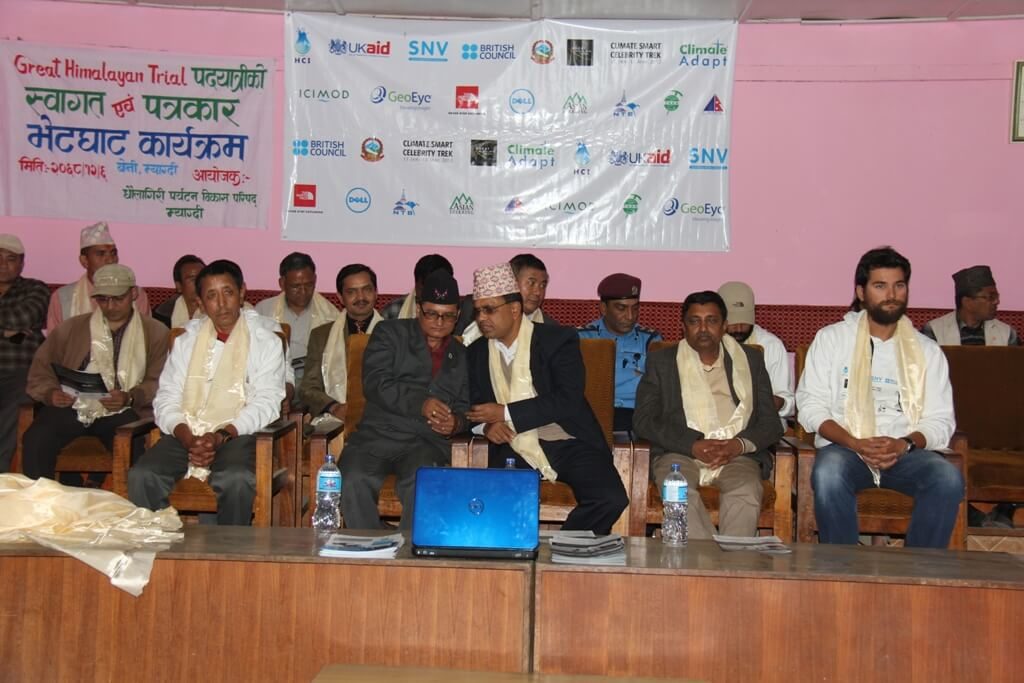
Speaking at the occasion, Honourable Minister of Environment said, the area of mountain region above the trail should be announced as an area of special environmental interest from climate change angle. He focused on the need to increase the scale of use of alternative energy such as solar, micro-hydro, biogas and use of improved cooking stoves as technology to mitigate climate change. He also assured that he would take necessary steps to address all issues raised by Apa and his team from their experience.
The areas above GHT are truly the Frontiers of Climate Battle in the Himalayas. By managing climate related challenges in those areas, Nepal can not only support its own people, but also help a large part of South Asia, including India and Bangladesh. Speakers on the occasion highlighted the significance of such an initiative.
Speaking on the occasion, Apa Sherpa said, “Glacial lakes have formed above Siklish at the height of 2500 M. He requested ACAP to take locals view into consideration while making policies that are impacting day to day life of the Annapurna Conservation areas
Dawa Steven Sherpa, the member of Climate Change Council of Government of Nepal said, home stay tourism and alternative energy be up scaled in the climate vulnerable regions. He requested NAPA to incorporate the issue of tourism as climate adaptive tool in their upcoming reports and studies. He also stated that the Ministry of Tourism participates in the Climate Change Council of Government of Nepal.
Day 64, Sunday 18th March 2012: Trek from Ghorepani to Tikot
Day 63, Saterday 17th March 2012: Trek from Ghandrung to Ghorepani
Day 62, Friday 16th March 2012: Trek from Luwang to Ghandrung
Day 61, Thursday 15th March 2012: Trek from Ghale Kharka to Luwang


Day 60, Wednesday 14th March 2012: Trek from Sikles to Ghale Kharka:
This is the sixtieth day of our trek on the Great Himalaya Trail. The past two months seem both long and short. On the one hand, looking back now at our first days when we started walking in the eastern border feels like it was many years ago. On the other hand, it seems unbelievable that we have already walked across more than half the length of the country.

These last two days have been of special importance to us. First of all it is the 60th day of our 120 day trek and so we have now officially come to the half way point. More importantly, we arrived at Sikles village yesterday afternoon. Sikles is a Gurung village and unique in many ways. It is located at the top of a hill that offers magnificent views of huge mountains towering above it. This special village offers an authentic view into traditional life of mountain people. The villagers still dress in their traditional attire and continue take tend to their daily chores, as their ancestors would have done hundreds of years ago. Some men were going to the forest to collect wood, an old woman was sitting on the porch, spinning thread made of nettles, while another was weaving a Radi (rug) from sheep’s wool on a old hand loom. Elderly gentleman were chatting and soaking up the sun at what was their version of a village square, a stone paved terrace that jutted out of the slope giving excellent views of the 5 Thars (wards) of their vibrant village of some 350 houses. It almost felt like my presence there was disturbing some preserved bygone era.
It was in this village that Dr. Chandra Gurung- “the boy from Siklis” was born and grew up. Dr. Gurung was a pioneer and he changed the way people would view conservation. He showed the world that by engaging local people and making them equal and respected stakeholders, conservation could become sustainable and successful. He was the key architect of the Annapurna Conservation Area Project (ACAP) that has since been replicated throughout Nepal and also in conservation areas abroad. Siklis lies within ACAP and is also the site of one of their main field offices.
During his tenure as Country Representative for WWF Nepal, Dr. Gurung also set up Kanchenjunga Conservation Area Project (KCAP) and on September 23rd 2006 KCAP made history by being the first conservation area to be handed back over to the community for its full management. It was Dr. Gurung’s vision that the local community should be the final stakeholders and custodians of their natural heritage. As Sikles lies in ACAP, Ghunsa is a village lies in KCAP. Ghunsa is similar to Siklis in that it is another traditional mountain community that has been scratching out a tough living on of the mountain slopes for hundreds of years. Similarly to Sikles, it is surrounded by pristine natural beauty and watched over by gigantic mountains.
On the 24th of September 2006, a day after the hand over ceremony of KCAP to the local community, Ghunsa entered the history books for all the wrong reasons. In the first few minutes of its flight back to Kathmandu from Ghunsa, the helicopter carrying many of Nepal’s top conservation and development minds met with a tragic collision that took the lives of all onboard. Dr. Gurung was one of the passengers. 51 days ago, we were in Ghunsa and visited the Memorial Chautari built in remembrance of those souls who were lost that day. It was here that we dedicated our trek to these inspiring heroes.
On our Journey so far, we have seen much of Nepal; both good and bad. I understand and appreciate with full humility now, what these great individuals have achieved, for our generation and for future generations to enjoy. Having been to Sikles has filled us with a new breath of inspiration and reminded me that what we deliberate do in our preciously short lifetime does make a difference.
Day 59, Tuesday 13th March 2012: Trek from Yangjakot to Sikles

Day 58, Monday 12th March 2012: Trek from Pass Gaun to Yangjakot
Day 57, Sunday 11th March 2012: Trek from Ghale Gaun to Pass Gaun

Day 56, Saturday 10th March 2012: Trek from Beshishar to Ghale Gaun
p>Day 55, Friday 9th March 2012: Trek from Paundi to Beshishar
Please Visit: http://www.youtube.com/watch?v=EqdVFZLf8tw
Day 54, Thurssday 8th March 2012: Trek from Ampipal to Paundi
Day 53, Wednesday 7th March 2012: Trek from Gorkha to Ampipal
Day 52, Tuesday 6th March 2012: Gorkha – Felicitation and Press Conference
On his historic trek on the Great Himalaya Trail Apa Sherpa reached and interacted with the local people and the media at Gorkha on 6th March, 2012. Day 52 of the trek, after walking 720 km since it began. Apa and his team were welcomed and felicitated by the government official, various professional organizations, political parties and people of Gorkha. The Chief Guest of the event was Honourable State Minister for Tourism and Civil Aviation Mr. Dilip Maharjan and the meet was also attended by Mr. Balkrishna Ghimire, Joint Secretary, Ministry of Tourism and Civil Aviation and the chairperson of Great Himalayan Trail Development Program (GHTDP).
Day 56, Saturday 10th March 2012: Trek from Beshishar to Ghale Gaun
p>Day 55, Friday 9th March 2012: Trek from Paundi to Beshishar
Please Visit: http://www.youtube.com/watch?v=EqdVFZLf8tw
Day 54, Thurssday 8th March 2012: Trek from Ampipal to Paundi
Day 53, Wednesday 7th March 2012: Trek from Gorkha to Ampipal
Day 52, Tuesday 6th March 2012: Gorkha – Felicitation and Press Conference
On his historic trek on the Great Himalaya Trail Apa Sherpa reached and interacted with the local people and the media at Gorkha on 6th March, 2012. Day 52 of the trek, after walking 720 km since it began. Apa and his team were welcomed and felicitated by the government official, various professional organizations, political parties and people of Gorkha. The Chief Guest of the event was Honourable State Minister for Tourism and Civil Aviation Mr. Dilip Maharjan and the meet was also attended by Mr. Balkrishna Ghimire, Joint Secretary, Ministry of Tourism and Civil Aviation and the chairperson of Great Himalayan Trail Development Program (GHTDP).
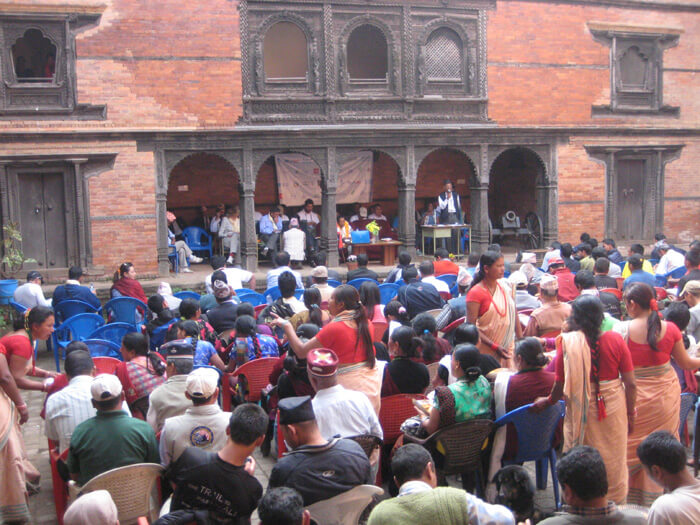
The Minister on the occasion, stated, ‘The government is fully committed to build GHT as one of the greatest tourism products of Nepal. The fact that it helps to deal with Climate Change makes it even more significant for Nepal.’
Speaking on the occasion, Apa said, ‘To promote this trail in an environmental friendly manner and to enhance stable tourism is our objective. I am honoured to be a part of GHT-CSCT to bring out the problems faced by the Himalayan communities because of Climate Change into national and international debate in order to provide relief to them.. My own life exemplifies how tourism helps a climate victim. GHT is Nepal’s response to Climate Change. We must convert the idea to action now.’ Prashant Singh, the event lead of GHT-CSCT and the CEO of HCI said, ‘Building GHT as the world’s first climate smart trail will make Nepal a global leader in addressing Climate Change in ways that are economically beneficial and socially inclusive. With the massive support of partners we are confident we will make this a reality soon.’
Apa Sherpa, the renowned mountaineer, who has climbed Mt Everest a world record 21 times, has been walking on the Great Himalaya Trail (GHT) – Climate Smart Celebrity Trek since January 15, 2012. He will be walking this 1700 km and 120 days long trek to highlight the impacts of climate change in the Himalayas, and to promote GHT. Back in 2009, on his 19thaccent to Mt. Everest, Apa had given a clarion call to the world, ‘STOP CLIMATE CHANGE, LET THE HIMALAYAS LIVE’. During this historic trek that is endorsed by the Prime Minister of Nepal and flagged off by the President of Nepal, he will visit hundreds of villages meeting thousands of people. To capture these interactions and stories and more importantly, to share them with the world, Apa is accompanied by Dawa Steven Sherpa (a two-times Mt. Everest Summiteer, a climate-activist and a blogger), Saurav Dhakal (a Climate Champion, journalist, videographer and blogger) and Sameer Jung Thapa (photographer). The trek is aptly named Climate Smart Trek, as Apa and his entourage are making every effort to keep their activities during the trek environment friendly and less carbon intensive. In the end, the trek will be converted to a carbon neutral effort by buying carbon offset to neutralise unavoidable carbon emissions.
Himalayan Climate Initiative (HCI), the organiser of this historic trek, is a civil society led national initiative to build a peaceful, prosperous and climate resilient Nepal, and to establish environmental, social and economic significance of the Himalayas across the globe. HCI is committed to convert the GHT into world’s first Climate smart trail. Apa’s heroic efforts are a step towards fulfilling the HCI vision. The vision is based on three pillars, namely: Climate Change Awareness, Climate Adaptation and Low Carbon Development. The current trek is applying Apa’s celebrity status to establish pro-poor sustainable tourism as a climate adaptation strategy in the Himalayas. Apa’s personal story of losing all he had in a climate change disaster back in 1985, and then gaining a global celebrity status by engaging in tourism and mountaineering, exemplifies how tourism can help a villager fight the impacts of climate change.
Day 51, Monday 5th March 2012: Gorkha – Rest day for interaction with local community.
Day 50, Sunday 4th March 2012: Trek from Arughat to Gorkha
Day 49, Saturday 3rd March 2012: Trek from Chautara to Arughat
Day 48, Friday 2nd March 2012: Trek from Betrawati to Chautara
Day 47, Thursday 1st March 2012Betrawati – Rest day (Interaction with local community)
Day 46, Wednesday 29th February 2012: Trek from Samundratar to Betrawati
Day 45, Tuesday 28th February 2012: Trek from Gyalthun to Samundratar
Day 44, Monday 27th February 2012: Trek from Pokhari Bhanjyang to Gyalthun
Apa Sherpa felicitated with the Guinness World Record
Apa Sherpa, the Nepali climber who has conquered Mount Everest a record 21 times was felicitated with the Guinness World Record. On the 44th day of the Great Himalayan Trail-Climate Smart Celebrity Trek lead by Apa, Guinness World Record Editor-in-chief Mr. Craig Glenday and his team met him and handed over a certificate at a function at Shree Saraswati Higher Secondary School in Gyalthum, Sindhupalchowk. Apa is accompanied by Dawa Stephen Sherpa (two time Mt.Everest Summiteer), Saurabh Dhakal and Sameer Jung Thapa, as part of a campaign to promote tourism and highlight the impact of climate change. The team that plans to walk 1,700 km has covered seven districts and a distance of 590 km so far.
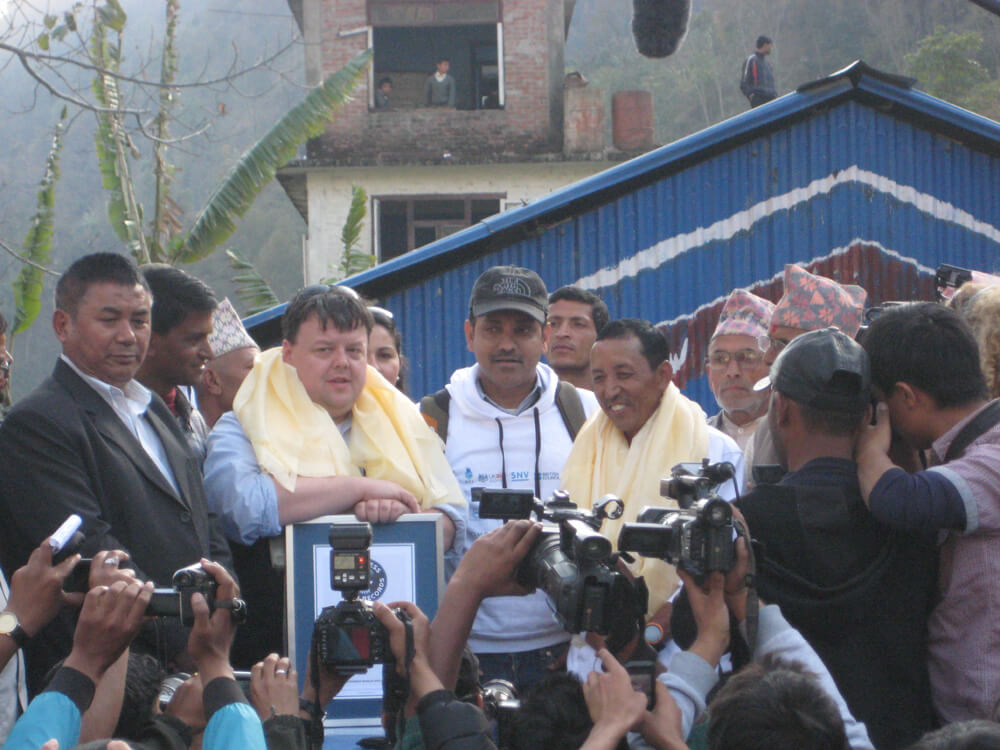
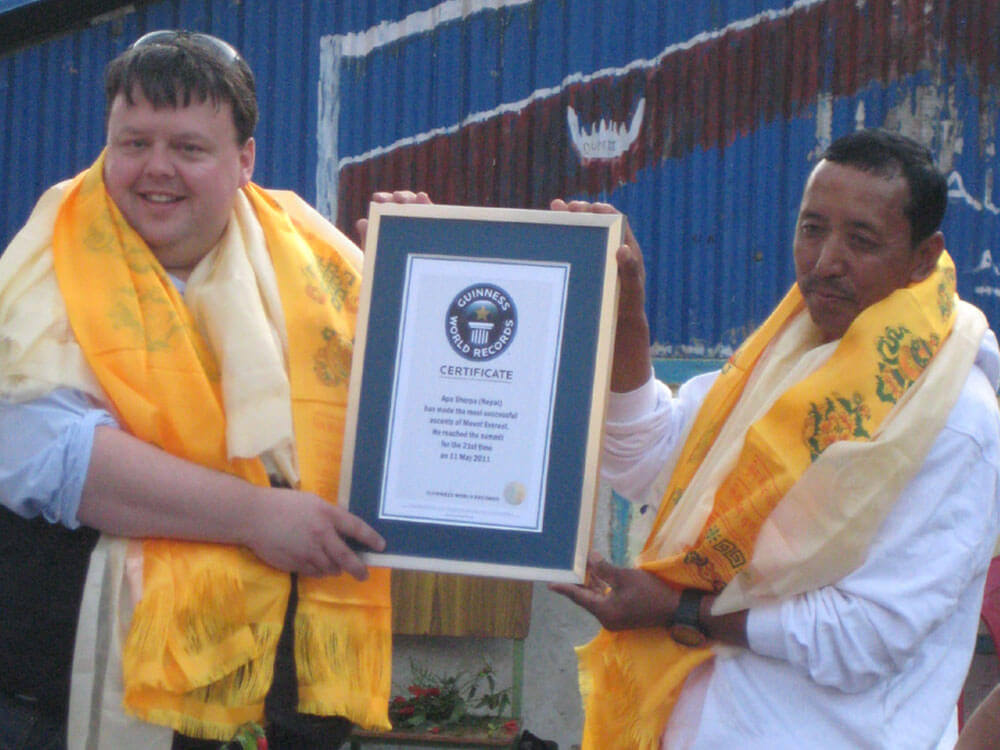
“It feels great to receive this honour as Mr.Glenday himself has traveled this far to hand over the certificate. I feel proud to be identified all over the world,” Sherpa beamed. He further said, interacting with people is altogether a new experience to him and added, “Now onwards I will not climb up to the top of the world but I have been witnessing the hills and people for the last one and half months which has given me ample of opportunities to learn about the communities living in the vicinity of mountains”. Hundreds of people attending functions expressed their happiness with the honour bestowed on Sherpa.
On the other hand Mr. Glenday expressed his feeling as “What Sherpa has achieved is unbelievable. He is not just a local hero but hero of the world. He is an inspiration to millions of people. It is a great privilege to hand him the official certificate. “The trip to Nepal has been amazing so far. It feels like I’ve been here for ever,” he added.
The sherpa from Thame, Solukhumbu; home town of Everest Legend Tenzing Norgay first summited Everest on 1990. Last year on May he conquered Everest for the 21sttime as the climbing leader of Eco Everest Expedition and became eligible for this award. He has shown his effort towards Everest clean up by engaging in Eco Everest Expedition since 2008 and continuing it for four consecutive years. He made his 18th summit in 2008, 19th in 2009 and 20thin 2010 and with Eco Everest Expedition organized by Asian Trekking to raise awareness about the impact of climate change.
Day 43, Sunday 26th February 2012: Trek from Sano Okhreni to Pokhari Bhanjyang
Day 42, Saturday 25th February 2012: Trek from Jalbire to Sano Okhreni
Day 41, Friday 24th February 2012: Trek from Barabishe to Jalbire
Day 40, Thursday 23rd February 2012:
Borderlands, Sindhupalchowk, Nepal
The Great Himalayan Trail-Climate Smart Trek led by Apa Sherpa arrived at Barhabise, Sindhupalchowk today completing 530 KM (40 days) of their 1700 KM long trek (120 days) on the Great Himalaya Trail (GHT) to raise awareness on ‘Climate Change in the Himalayas’, and to promote the development of the GHT to build the climate resilience of Nepal’s most climate vulnerable communities.
The core GHT-CSCT team comprising of ApaSherpa (21 times Mt. Everest summiteer), Dawa Steven Sherpa (Mountaineer and Climate ambassador), SauravDhakal (British Council International Climate Champion and Journalist) and Samir Jung Thapa (photographer) begun their journey on 15thJanuary, 2012 after receiving the best wishes and Nepal’s national flag from his Excellency the President of Nepal. The team has later been joined by Linda Bezemer (SNV / GHTDP Nepal) and ParibeshPradhan (SDC). Her Excellency German Ambassador; Ms. Verena Grafin von Roedern also joined them from Tumlingtar, Khandbari to Lukla from 1st February to 10th February to support and encourage the team members.
Overwhelmed by the welcome of the villagers in traditional ways and that of government officials all over the GHT, Apa’s team interacted with the national and international press at a press conference organized at Borderlands Resort. The representatives of Corporate Partners of the trek, North Face and Asian Trekking also joined the Press Meet.
On the occasion Apa Sherpa said, “I have a message for my fellow Nepalis. My message is rooted in my own story. Climate Change destroyed most of my properties back in 1985 Dig Tsho Glacial Lake outburst. I succeeded climbing Mt. Everest first time in 1990, and since then climbed it 21 times in 21 years. Tourism gave me my life back” The GHT is projected by Apa and his team as a pro-poor sustainable development product that can help address the impacts of Climate Change in the Himalayas
The team has within it climbers who among them have climbed Mt. Everest a total of 41 times.
Team members Dawa Steven Sherpa and SaurabhDhakal shared their observations about the impacts of the Climate Change, and the potentialities of existing and new tourism destinations within GHT.

The GHT-CSCT is organized by Himalayan Climate Initiative (HCI) with the endorsement of Climate Change Council led by the Prime Minister of Nepal. It is supported by the Ministry of Environment, Ministry of Tourism and Civil Aviation, UK AID , British Council, SNV, NMA, NTB and TAAN. The event has received support of corporate partners Geo-Eye, Asian Trekking, North Face and Dell.
Prashant Singh, Founder and CEO of HCI and the Event Leader for GHT-CSCT said “Apa’s efforts are not just for Nepal and Nepalis. Himalayas provide water to almost 1.5 billion people in Asia. Taking steps to maintain the ecological integrity of the Himalayas is truly serving a global cause. The world must join Apa in his efforts.”
The Great Himalaya Trail Development Progamme (GHTDP) is harnessing tourism with a market-led approach to improve livelihoods and bring sustainable development opportunities to remote and poor communities through the creation of an iconic and globally significant new tourism product for Nepal. The “Great Himalaya Trail” (GHT) is a network of existing paths and trade routes spanning the length of the country from Darchula and Humla in the West to Kanchenjunga in the East, packaged and promoted into one of the world’s great walks. Over the longer term, the GHT has the potential to traverse the length of the Himalayan Range stretching through impoverished mountain areas of Pakistan, India and Bhutan.
For more information please log on to: www.thegreathimalayatrail.org
Day 33, Thursday 16th February 2012:
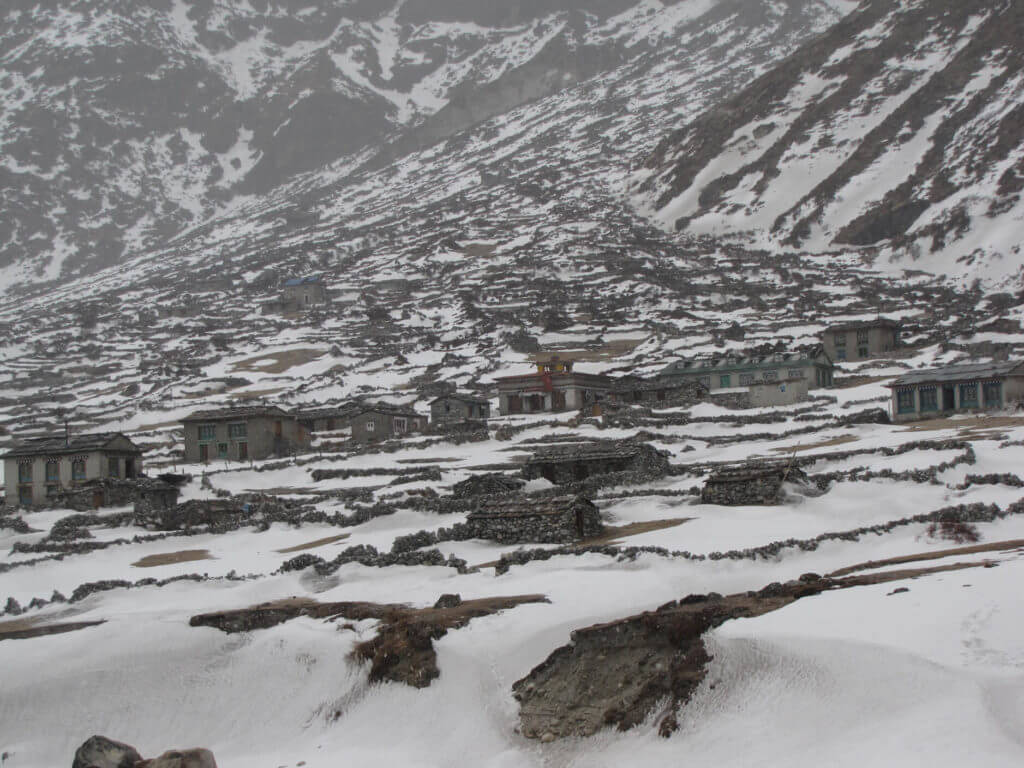
Day 32, Wedesday 15th February 2012:
Crossed Tashi Lapsa pass and reached Chobug.
Day 31, Tuesday 14th February 2012:
Thapngpo to Thashi Phuk (5600m)
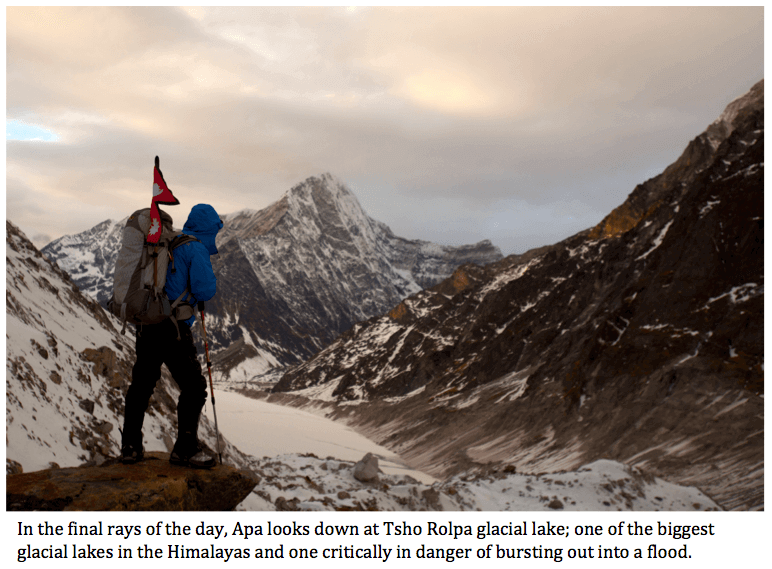
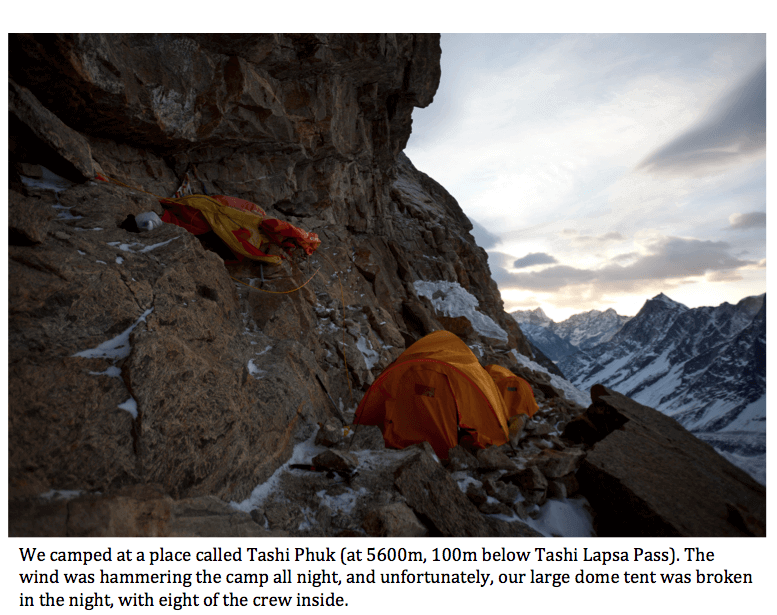
Day 30, Monday 13th February 2012:
Khumjung to Thangpo (4350m)
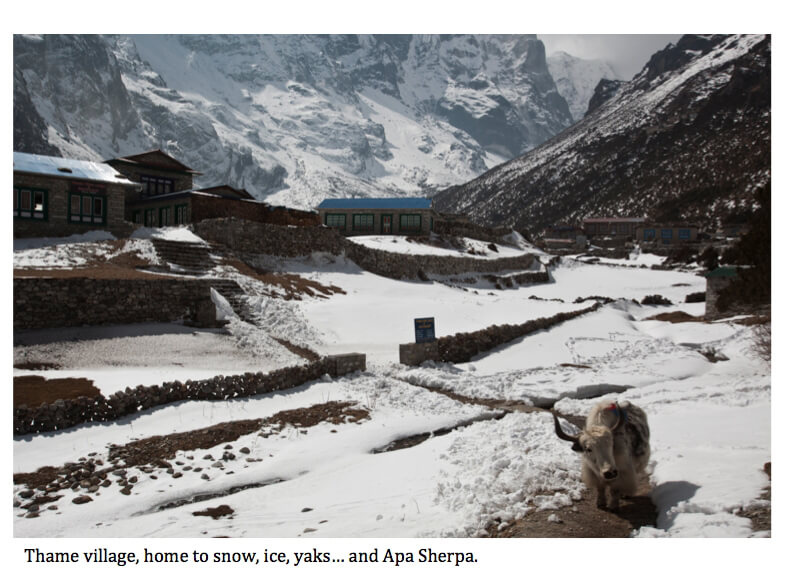
Day 29, Sunday 12th February 2012:
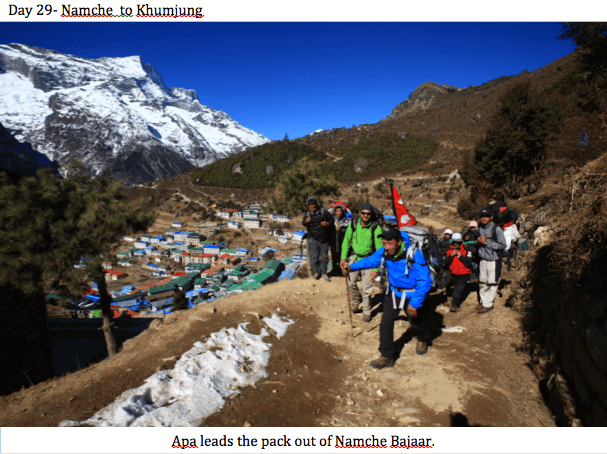
Day 28, Saturday 11th February 2012:
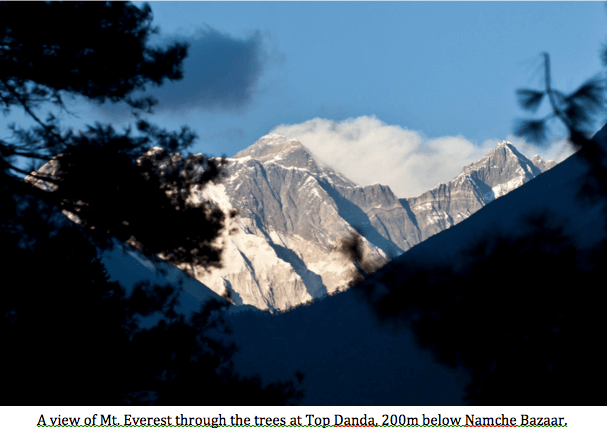
Day 27, Friday 10th February 2012:

Day 25, Wednesday 8th February 2012:
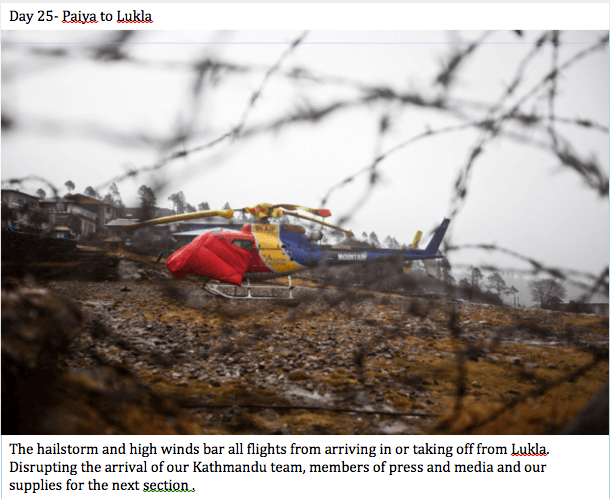
Day 24, Tuesday 7th February 2012:


Day 23, Monday 6th February 2012:
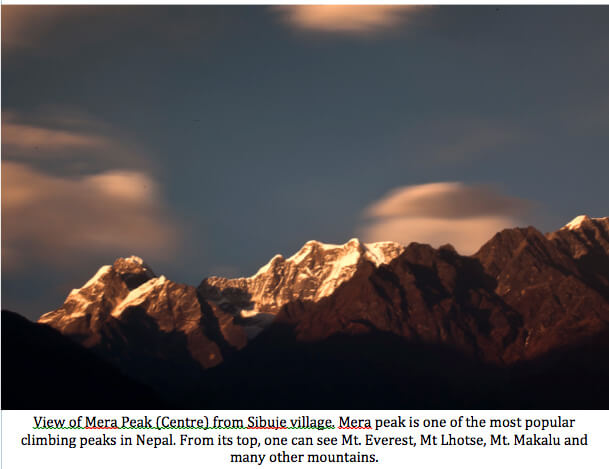
Day 22 , Sunday 5th February 2012:
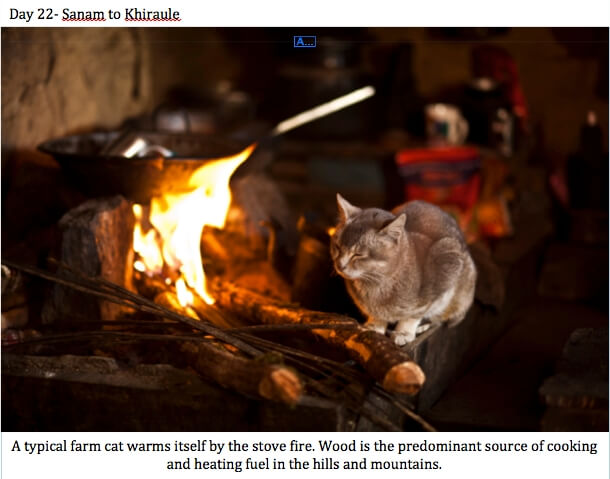
Day 21, Saturday 4th February 2012:

Day 20, Friday 3rd February 2012:
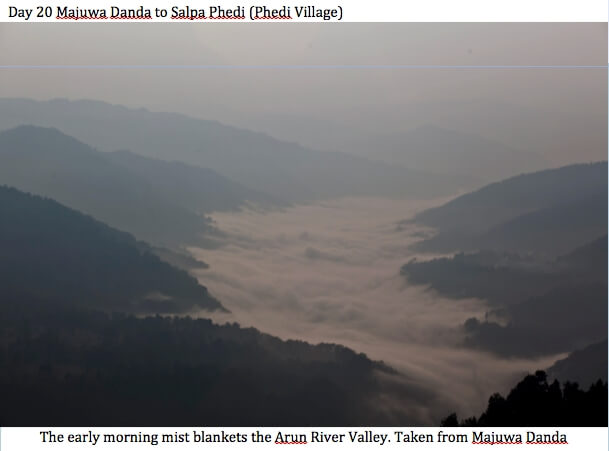

Day 19, Thursday 2nd February 2012:
Apa Sherpa and his team members who are walking the 1,700 km long Great Himalaya Trail resumed their trek from Khandbari Thursday.They were welcomed in a traditional manner by a score of people at Khandbari. This included the senior officials of the Government of Nepal, FNCCI (Federation of Nepalese Chamber of Commerce and Industries), NFJ (Nepal Federation of Journalists), representatives of different political parties and civil society.

Amidst a public felicitation ceremony Apa said, “It is important to develop roads but let us make sure that we do not destroy the traditional trekking trails.” The team has already walked 242 km in last 17 days. They began their historic trek on GHT from Ghunsa, the eastern most destination of the trek to pay respect to the conservation pioneers who lost their lives in a tragic helicopter accident back in 2006.
Talking about the experience so far Dawa Steven Sherpa said, “the impacts of the Climate Change can be seen clearly along the trail. It is lessening the agricultural productivity and causing massive landslides hence threatening the existing trails that are already fragile.”
Day 10, Tuesday, 24th January 2012: By Dawa Steven Sherpa
| Accomodation | Tented Camp. Dinner and cooking in local lodge |
| Village | Gyabla |
| Altitude: | 2698m |
| GPS: | N, 27°36’51.2.”- E 087° 52’.25.7”-5t |
| Route | A short walk from Ghunsa, via Phale. 12.26Km |
| Route Condition | A beautiful walk through alpine pastures along the river bank on a wide flat valley between Ghunsa and Phale. There are numerous large landslides between Phale and Gyabla so one must be careful when crossing these area. Always be alert for falling stones. |
| Electricity: | Small solar panel for home lighting |
| Telephone connectivity: | Local Land line, only works when solar panels have charged up the battery in the morning. |
Last night, Apa had his own single man tent and the three of us; Samir, Saurav and Myself; slept in one 3 man tent. It was the coldest night sleep yet and I now understand why the all the Ghunsalese leave the village for the two coldest months of the year. Ghunsa is in such a deep gorge that in the winter, the sun only hits it at 11 am in the morning.

Ghunsa also surprised us in another way. Though it was an empty ghost town while we were there, the village is in fact very large and the architectural style is simply unique. The houses are all made of wood. The floor is raised on stilts and there are stone or wooden steps leading to a balcony area. It is from this balcony that one enters into the living area. Under the raised floor, they store firewood and keep the cattle.
Just outside of Ghunsa we walked along the riverside trail to a very significant point in our journey; the “Conservation Memorial Chautari.” The memorial was built in remembrance of the 24 souls that lost their lives here in the helicopter crash on 23 September 2006. Amongst the 24 were some of the finest leaders and architects of Nepal’s conservation movement. Also amongst those who perished, was my very dear cousin who was the pilot of that fateful flight. The memorial came to me as a shock and I was overwhelmed grief that I thought I had put away a long time ago. We placed Khadas (silk Scarves) on the memorial and dedicated our journey across Nepal to the souls that were lost that day.
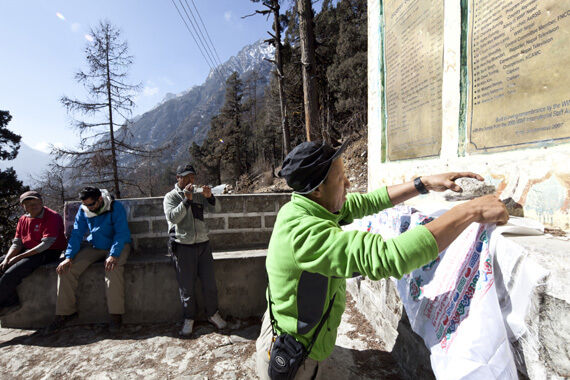
An hour later, we arrived in the village of Phale, where the Ghunsalese settle for the winter. Without much warning, while we were waiting for our lunch, the locals from Phale and Ghunsa gathered and organized an adhoc welcome event, filled with drinking chhyang (rice wine) and dancing. After lunch, we left Phale and walked down to Gyabla, in a number of cases over some landslide areas. The local people have done a good job in carving out a decent trail but we kept alert for falling stones or debris from above.
In Gyabla, we again set up our tents but we were much lower in altitude and in warmer temperatures. Plus, the 16 houses of Gyabla came down to greet us after dinner and they all brought their best Tongba (fermented millet drink). Soon enough a dance program started where our sherpas also joined in. They then shared and taught each other the dances of their respective region; Sherpa dances from Taplejung (Kanchenjunga Region) and dances from SoluKhumbu (Everest Region). Even after I went to bed I could still hear the singing and dancing going on.

Day 9, Monday, 23rd January 2012
| Accomodation | Tented Camp. Dinner and cooking in local lodge |
| Village | Ghunsa |
| Altitude: | 3402m |
| GPS: | N, 27°39’34.7.”- E 087° 56’.05.0”- |
| Route | Over the Silion Pass, Mirgin La Pass (4633m) (AKA Selele Pass). 15.02 Km |
| Route Condition | Steep for the first section but then relatively flat as we go over the high pases. Ankle deep snow right through until Ghunsa. Great weather but tough walking on the soft snow. |
| Electricity: | Micro Hydro Plant working in Ghunsa. Limited times for the winter as the village is empty. Ghunsa locals shift down to Phale village for two months of the coldest winter. |
| Telephone connectivity: | None |
It was another tough day for us. We knew that we were walking two camps instead of one, plus walking to Khangla also gave us a hint that the trail ahead would be snow covered. Add to that the fact that all team is fully burdened with big loads. We set out early, around 7 am, and immediately started climbing some 500 meters up. The first part was pleasant as the sun came out and we were walking on firm ground. After some about an hour, we came up to a large frozen pond where some trekking groups also set up camp. From here on we met the snowline and started climbing up, and slipping, and sinking in up to our knees; a wholly exhausting activity.
But it must be mentioned here that the view of course was amazing. Looking behind, we could see the deep valley where we climbed up from. Following the valley up north, we could see the Yarlung glacier, Nepal’s biggest glacier. Unfortunately, like other glaciers in the Himalayas, the Yarlung glacier has also shrunk far below the lateral moraine on its sides. Normally, a healthy glacier would be bulging out and above the moraine. What was still an amazing sight was the tail end of the Kanchenjunga range that joined up with the Kyabru peaks to for a solid and jagged barrier between Sikkim and Nepal.
A far greater view was in our expectation when we reached the Mirgin La pass, as one is able to see Kanchenjunga and Jannu Himal (Aka Kumbhakarna) from there. Enroute, we crossed the first pass, which is called the Silion La. From here, I was astonished to see the immense Makalu range to our west, with Mt. Makalu standing overwhelming higher than any other peak in the area. It was a reminder to me that we are amongst the highest peaks in the world.

Unfortuantely, as the afternoon came, so did the wind and with it moisture, which formed a thin blanket of fog around us. The temperature again dropped by more than a dozen degrees and visibility was reduced to about 10 meters at best. In these conditions, not only could we not see the mountains any longer butwe couldn’t even see where the path was. We were just following in the footsteps of the trail breaking Sherpas, who were Lhakpa and Sonam. By the time we reached camp it was dark, and Apa and Samir even got lost in the forest on one occasion.
When we arrived in Ghunsa, Lhakpa and Sonam had an amazing story to tell. The way they found the way was that they also followed footsteps… of a snow leopard. When I spoke to the local Ghunsalese they told me the amazing fact that the Snow Leopards happily walks on the trekking trail and can find it even under thick snow. We were lucky to have such an accomplished guide for the day, otherwise we might have been much slower.
Day 8, Sunday, 22st January 2012: by Dawa Steven Sherpa
| Accomodation | Basic Lodge |
| Village | Cheram |
| Altitude: | 3880m |
| GPS: | N, 27°34’10.0”- E 087° 58’.38.0”- |
| Access: | |
| Route | To Khangla Pass and back |
| Electricity: | None. Solar not working in the off season |
| Telephone connectivity: | None |
This was the toughest day we have had until now. It was rest day for most of the crew, except for Apa Sherpa, Samir and Myself and two of our support crew, Lhakpa Sherpa and Tenzing Dorje Sherpa. Our aim for the day was to head over to the furthest point on our trek, which would be the Khang La pass on the Sikkim Border. According to the map, it would be about 10 Km from our lodging in Cheram, and of course 10 Km back. This would normally be a 8 hour day, but nature had something else in store for us, of course, it being winter.

The moment we left from Cheram at 6:30 in the morning till we came back to the lodge we trudged through ankle deep and knee deep snow. Apa and TenzingDorje had to break trail all day through crusty hard snow that would break when we put our weight on it. Underneath was dry sugary snow that offered no grip and we kept slipping back with every step. In total it was an ascent of a thousand meters up.
As the day went by very slowly, we came to the realization that we would not be able to make it to our destination, which is the border with Sikkim. At 1pm, after winding around valley after hidden valley, we finally clambered up to the final valley. At the lip of the valley, we decided to leave our bags behind and make a final dash. A half an hour later, we could see the pass above us, but still 2 Km away. At this point I made the decision that it this was far enough. It would take still take another couple of hours to get there and at least another 6 hours to get back.
We had our photo ops at this point, with Apa holding high the Nepali flag. Within 15 minutes, we returned back down the way we came, and for the first time on our trip, we started walking westwards. We finally arrived at camp at six thirty, a 12 hour day. At camp, Bhuwan our cook, warmed us with hot soup and a hearty portion of DaalBhat and off we went to bed for a well deserved rest and in anticipation of another epic day, the crossing of Selele Pass, in similar conditions.
Day 7, Saterday, 21st January 2012: by Dawa Steven Sherpa
| Accomodation | Basic Lodge |
| Village | Cheram |
| Altitude: | 3880m |
| GPS: | N, 27°34’10.0”- E 087° 58’.38.0”- |
| Access: | 17.35Km over tough terrain and soft snow. Many landslides along the route due to Sept. 18th earthquake. |
| Route: | |
| Electricity: | None |
| Telephone connectivity: | None |
We slept in a log cabin last night and the fire in the hearth filled the log with smoke. Some of us slept in the cabin while the other boys slept in the shed next door. It was a drafty and cold night sleep with the cabin filled with smoke from the fire in the hearth, but we were grateful to the owner for coming all the way up the hill just to accommodate us.
Similarly today in Cheram, the lodge owner Tshering Sherpa has come all the way with us to open up his lodge for us. This is the same Tshering who owns the lodge in Yamphudin. He has been walking with us for the last two days and his chat keeps us all entertained and educated. He told us about the times as a child when he had walk these rough trails waist deep in snow. It sort of put us to shame and we avoided complaining too much about the foot of snow we had to walk through al day.
But it has been another tough day. We walked over 10 hours today over some rough forest trails, in many cases even destroyed by the landslides. The entire morning we walked down hill from the pass and being the north-facing slope, the sun never hit us until noon and the entire slope was covered in snow. In the afternoon we had some glorious sun and the finally entering the mountainous country, we are all in our element.

Tomorrow, we head further east to the Khangla Pass on the border with Sikkim. This will be the most eastern point in our trek. After tomorrow, we finally start heading westward, chasing the sunsets.

Day 6, Friday, 20th January 2012: by Dawa Steven Sherpa
| Accomodation | Log Cabin, LhaseBhanjyang Pass ·(No toilet facilities) |
| Village | LhaseBhanjyang Pass. (no village) |
| Altitude: | 3395m |
| GPS: | N, 27°29’55.2”- E 087° 53’.48.3” |
| Access: | 9.24 Km along rough forest trails. Uphill all the way. |
| Electricity: | None |
| Telephone connectivity: | None |
Today we walk only uphill- An ascent of over 1300m. Leaving Yamphudin, we aimed straight up to the highest hill top and trudged our way there. We walked up through rough forest trails for over 7 hours today and everyone arrived almost destroyed. Half way up the trail, we came across a lone cottage with a woman and her two toddler. The woman offered us salty butter tea and we were thankful for it. As we continued up higher and higher on the trail, the clouds started to gather and it began to snow. Tonight we are staying in a little wooden cabin in a pasture on mountain pass, surrounded by snow. Very kindly, the owner of the cabin walked all the way up with us to let us stay here.

It must just be serendipity that we walked uphill today to the highest point yet, since it is also Apa’s birthday. Today Apa turned 52 years. For his birthday our cook Bhuwan Limbu, made special cake out of biscuit crumbs and flour in a steel bowl. Apa was very surprised as that was the last thing he expected in this place.
Happy Birthday Apa Sherpa!
Day 5, Thursday, 19th January 2012: by Dawa Steven Sherpa
| Accomodation | Yamphudin Guest House, Proprietor Tshering Sherpa. Also, large camp site for camping and water available on site. |
| Village | Yamphudin (Sherpa-Gaon),Taplejung District |
| Altitude: | 2052m |
| GPS: | N, 27°27’26.8”- E 087° 53’.55.5”- |
| Access: | 13.61 Km from PhungpheDanda. Excellent trails all the way. |
| Electricity: | Solar panels for lighting and charging electronics |
| Telephone connectivity: | STM Phone regular. NCell irregular service. NTC, andNamaste Mobile and Sky CDMA not working |
It was another fantastic day of walking today. We left Phungphe Danda at around 8 am again. 8 am is now our standard time of departure. We had a shorter day ahead so we walked at a relatively comfortable pace.
The first major stop along the way was Mamankhe village and we were surprised to find that the entire village had come out to welcome us. The villlagers of Mamanakhe, had arranged a traditional Limbu welcome for us all with the Chabrung drums and Narsingebaja (a long curled up copper horn). We were escorted to the school compound and entertained with their traditional dances and a visit to the only Limbu museum in Nepal. Apa spoke on the importance of tourism as a tool for development and adaptation to climate change. Turning around to the students, he also told them to study hard so they don’t have to have as hard a life as he has had.

Many of the Mamankhe villagers are involved in the farming of cardamom spices. When asked if they had noticed anything different in the production of cardamom, they told us that the weather was changing and become more extreme. On the one hand they said that the Uttis tree grow faster than before because it’s warmer. Cardimom plants grow under the shade of the Uttis trees and benefit from this. On the other hand, they are also experiencing more frost which is destroying their crop.
Leaving Mamankhe, we walked on excellent trails all the way to Yamphudin, where we stayed for the night. The trails are really impressive here in this area as the TRPAP (Tourism for Rural Poverty Alleviation Program) had invested a lot of time and effort to pave the entire trail. Yamphudin is a beautiful village, high above the river, and inhabited by Sherpa people. But the Sherpas of the Kangchenjunga region have a very different tradition and language to that of the Solu Khumbu (Everest Region) where we are from.
We were just settling into the quaint lodge of Tshering Sherpa in Yamphudin, when we were informed that the entire village had gathered at the monastery to welcome us. So we put on our boots again and went to a large field with lots of people with Khadas- silk scarves that are given on special occasions. Soon the whole team was covered in Khada and the formal event happened. As chief guest in so many functions, Apa’s speeches are getting better and better. I think that by the end of the trek Apa is going to be a great orator or politician. At the function, and afterwards, the locals treated us to their best Tongba- an alcoholic drink of fermented millet and hot water. It is said that Taplejung district has the best Tongba in whole Nepal and we can all testify to the truth in this!
Day 4, Wednesday, 18 January 2912: By Dawa Steven Sherpa
| Accomodation | Home Stay |
| Village | Phungphe Village, Taplejung District |
| Altitude: | 1842m |
| GPS: | N, 27°24’27.0”- E 087° 51’.49.3”- |
| Access: | 16.3 KM walk from Sinbu. The path is good paved until Kade Bhanjyang but becomes narrow and in a few case dangerous with landslide. Journey time 9 hours |
| Electricity: | Solar panels for lighting. |
| Telephone connectivity: | Sky CDMA Phone NCell, NTC and Namaste Mobile not working |
As we made our way to the lunch spot in KandeBhanjyang, we came across a group of “cotton fluffers” from the Madhes. They were travelling throughout the district with their unique bow shaped instrument and bundles of cotton, offering to fluff up the traditional cotton filled blankets found in Nepal. Surely it’s good business sense to offer their services in this cold winter.
A little higher we arrived in hamlet, where I found Samir and Apa joking with some villagers in their front yard. There was a flurry of activity for a wedding that was happening the next day. We were invited to stay the night for the wedding but courteously refused and continued up the hill. Four young Limbu men accompanied us, and one of them was the groom of the wedding. Samir, being who he is was asking all sorts of compromising questions to which the would-be-groom could do nothing but giggle. The other three young men were very excited as it turns out that they were unmarried and they were looking forward to teasing the brides friends…and perhaps find their on bride.
When we arrived for lunch, the food was already being prepared by our cooks. The lunch was sunny and a warm breeze blew was rustling the leaves in the trees. Looking in the distance, we could see and immense ridge that forms the Nepal-India border. Following the ridge to the North, we could see a huge massif covered in snow, Mt Kanchenjunga. Curiously, as with Mt. Everest the only peak that is bare rock is the summit. At the lunch spot, there was a group of five policemen waiting for us. The policemen were sent from the local station to escort Apa for the next two day. When I said that there was no need for security as we were a large group and knew the way, their face brightened up as they saw the opportunity to avoid some long walking. Unfortunately for them, their superior said over the radio that the orders are to be followed and so Apa now has his own bodyguard unit until tomorrow. He is a National Treasure after all !
Along the way, we met a musician repairing large drums in his home and playing tunes as he tested them. He told us that it is now the wedding season and that he is in high demand because the men in his village of Khesewa are especially recognized for their musical skills. To a small crowd of women, children and shaggy Nepali Tourists, he kindly played his rhythmic and rather trancelike tune as he performed the wedding dance. I am really touched by how quickly people open up their homes to us and give us a glimpse of their daily lives.
Tonight we stay at Phungphe village at 1842m. We arrived here in the dark so haven’t had a chance to see how the village looks and I look forward to the morning when I have a chance to walk around.

Day 3 Tuesday, 17 January 2012: By Dawa Steven Sherpa
| Accomodation | Home Stay: PurnaBahadur and Goma Maya Bhattarai’s home |
| Village | Sinbu Village,Taplejung District |
| Altitude: | 1663m |
| GPS: | N, 27°22’29.1”- E 087° 46’.34.6”- |
| Access: | 14.9 KM walk from Suketar. Journey time 4hours 30mins |
| Electricity: | Micro Hydro. From 5pm to 10pm |
| Telephone connectivity: | NTC Landline NCell, NTC and Namaste Mobile not working |

We woke up at 6:30 this morning to a cold and misty day. There was much to do before wecould start walking. After some black tea and biscuits as our breakfast we set about separating our gear. All clothes and personal effects are to be carried by ourselves. Electronics, solar panels, batteries, fuel, food and camping gear are to be carried by our 10 man strong group of support staff. (I will introduce our support staff and their roles in a later blog.)
esterday, the Tourism Development Committee (under the District Development Committee) had been in contact with us frequently to plan and arrange the formal farewell event on behalf of Teplejung district. This morning, shortly after 8 am a pick up truck sped up the dirt road to our hotel and stopped promptly. A policeman jumped out asked who was Apa Sherpa, went over to him and shook his hand. The police vehicle was our transport into town and to the formal program. It was amazing to see the wide expanse and deep valley below us, especially since the sun snuck out of hiding and warmed us all up.
The program was chaired by the Chief District Officer (CDO) and attended by the Local Development Officer (LDO) and the representatives of all the major political parties in the Region. Also attending were the district chief of police, district head of army and the district of the Armed Police Force. Many local journalists and inhabitants of Taplejung Bazaar turned up for what felt like a heroes welcome. Other than the words of support by all attending, we were also given a great tour of the town where curious and amused townspeople lined the streets and followed us.
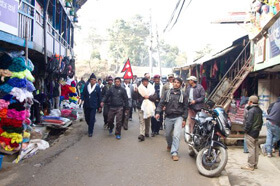
After an early lunch in Taplejung, the police vehicle dropped us off back at the hotel in Suketar. By this time, the support team had already left for our next stop. We strapped our rucksacks on and took the first steps of our long journey at 11:55 am. In expectation of the delay, we all decided to walk, not to Khesewa today as originally planned but rather just as far as this quaint and super friendly village of Sinbu.
Every long journey stars with the first small steps, and I am very happy to say that our steps were strong and confortable. Apa Dai, as usual led the pack with his steady pace and the Nepali Flag fluttering above his back pack. En route, we met many people who were curios as to why four Nepalese were walking through their villages. In one instance, an elderly gentle shouted out to Apa from a far and wished him great success and safety on the journey. Many people along the way had heard over the radio that we were coming and were looking forward to meet Apa, a person whom they consider a pride of Nepal. It is not until today that I realized really how proud we as Nepalese are of the achievements of Apa Sherpa; a humble person of immense stature and one who has done so much to make Nepal shine bright in the eyes of the world.

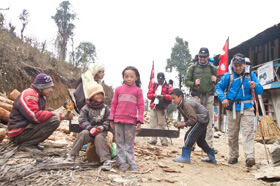
Day 2 Monday, 16 January 2012: By Dawa Steven Sherpa
| Accomodation/Camp Site: | Everest View Hotel, Suketar, Taplejung |
| Altitude: | 2417m |
| GPS: | N, 27°21’08.1’- E 087°41’70.0’- |
| Access: | By Tarmac Road, A large STOL Airport is under construction and should be ready within a year. |
| Electricity: | None |
| Telephone connectivity: | NTC Landline and NTC Mobile(very sporadic and unreliable). NCell and Namaste Mobile not working |
The day started early for us today as we had a very long journey ahead of us from Fikkal to the end of the road at Suketar, just above Taplejung Bazaar. Last night, Fikkal FM radio station also met us and interviewed us about our long walk and what we hoped to achieve. They then promptly informed the Federation of Nepalese Journalist(Ilam Branch) who requested us to visit Ilam Bazaar for a small interaction program with their members.
We left promptly at 8:30 am and arrived in Ilam Bazaar at 10 am. After a one-hour program with the journalists, we made our way further up the road through Ilam District and on to Panchthar District.
At about 1 pm we stopped for a quick lunch at Phidim, the district headquarters, but it turned out to be anything but quick. Very soon, information spread that Apa Sherpa had arrived in Phidim. I am truly amazed at the rapidity with which the Nepalese police were tracking the progress of our bus and passing the information on to the district headquarters. Without warning the local leaders, police officers, and bureacrats were at the restaurant and whisked us away to an impromptu event in the center of town. There, the Assistant Chief District Officer chaired a formal program, attended by large crowd of Phidim citizens, to wish us well on our trip.


Our foreheads and faces were then covered in abir; powder as an auspicious sign. Before we knew it, it was 3 pm and we were still hours away from our final destination. Very soon, being winter the day gave way to night and the mist started to turn into drizzle. At 7:30 at night, we arrived in Taplejung Bazaar. We continued on up for about half an hour, leaving the tarmac road. After pushing a stuck tractor out of the slippery way we finally arrived at Suketar in a heavy cold drizzle feeling bruised and battered from the drive but excited about the walk ahead.
Day 1 Sunday, 15 January 2012:
The team memebers of GHT (Apa Sherpa, Dawa Steven Sherpa, Saurav Dhakal and Samir Jung Thapa) flew to Bhadrapur today. After they reached Bhadrapur, they were wecomed by big crowds of local peoples and authorities. Asian Trekking’s guides, cooks, camp staffs and porters joined them at Bhadrapur Airport and now they are headed to Fikkal by vehicles where they were welcomed by local people..

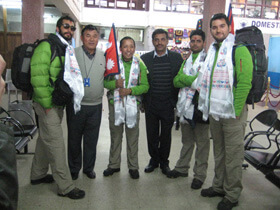
12th January, Thursday, Kathmandu, Nepal; Apa carries National Flag across Nepal

His Excellency handed over the national flag to Apa Sherpa and his team which they will carry on their historic trek that begins from Taplejung in Eastern Nepal and ends in Darchula in the Far West. The trek will commence on 15th January 2012 and end on 13thMay 2012. Today’s event will mark the beginning of this historical trek that would take Apa Sherpa ,Dawa Steven Sherpa, Saurav Dhakal, Samir Jung Thapa to hundreds of villages across 20 different districts of Nepal over a four month period.

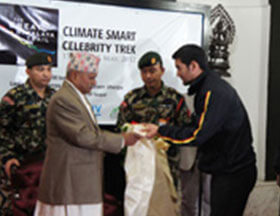
Speaking on the occasion Rt. Honorable Dr. Ram Baran Yadav, President, Republic of Nepal said “This trek will help to identify the impacts of Climate Change in the Himalayas, and showcase how sustainable tourism can be used as a tool for poverty reduction and to build climate-resilience among impoverished mountain communities in Nepal”.
Apa Sherpa said“The world wants to support Nepali communities in their climate battle but they need to be told how and where. My effort to walk from East to West in Nepal is to find places and people that need the attention and help of the world in their climate battle”.
Prashant singh said “The support of Government of Nepal and its development partner private sector and media has been tremendous. We now expect global celebrities to lend their voice for the people in the Himalayas suffering from climate change”.
Press Release of The Great Himalaya Trail – Climate Smart Celebrity Trek on 21 Dec.2011:
A well attended and highly interactive press meet happened on 21st December afternoon at Nepal Tourism Board in the presence of Chief Secretary, Government of Nepal, Secretary, Ministry of Environment, Joint Secretary, Ministry of Tourism and Civil Aviation and representatives from development agency namely DFID, SNV, British Council, NTB and TAAN to declare the launch of The Great Himalaya Trail- Climate Smart Celebrity Trek.

Apa Sherpa (21 times Mt. Everest summiteer) and Dawa Steven Sherpa (Two times Mt. Everest summiteer) will embark on 1,700 KM and 120 days long Great Himalaya Trail on 15thJanuary, 2012. The event has been endorsed by Climate Change Council, the apex body of Government of Nepal headed by Rt. Hon. Prime Minister. The mountaineer duo will be accompanied by Saurav Dhakal- British Council International Climate Champion and Samir Jung Thapa- the official photographer of the event.
Speaking at the function organized to inform about GHT-CSCT, Chief Secretary of the Government Madhav Prasad Ghimire said that the trek would be a successful event, for the first time, in linking the issues of climate change in the Himalayas, poverty in the region and the tourism potentiality there for the prosperity of the Himalayan people. He also assured maximum support from the government in making the event a grand success. Similarly, Krishna Gyanwali, secretary at the Ministry of Environment said that the ministry would take initiative in joining the delegates from the mountainous countries in the trek at certain points of the trail.
The Great Himalaya Trail (GHT) is a long distance walking trail along the length of the Himalayas in Nepal envisaged under GHT Development Program led by Ministry of Tourism and Civil Aviation. GHT is likely to help channeling tourists and pro-poor tourism investments to less visited and under developed districts of Nepal. The Climate Smart Celebrity Trek (CSCT) is being organized to raise global awareness on the impacts of Climate Change in the Himalayas and showcase how sustainable tourism can be used as a tool for poverty reduction and to build climate-resilience among impoverished mountain communities.
GHT-CSCT is organized by the Himalayan Climate Initiative (HCI) in coordination with Government of Nepal, particularly Ministry of Environment, and Ministry of Tourism and Civil Aviation, with the support of DFID, British Council, SNV and GHTDP Partners. The event has already received support of Corporate partners Geo-Eye, Asian Trekking, North Face and expects to earn the support of several Corporate Partners in the days to come.
Some of the major highlights of the GHT-CSCT are:
The Great Himalaya Trail-Climate Smart Celebrity Trek (GHT-CSCT) will traverse some of the most rugged and breathtaking mountain landscapes on earth and will pass beneath eight of the world’s highest peaks.
The GHT-CSCTwill cut through 20 districts in the mid-hills and low mountains of Nepal, many of which have been reported as vulnerable to Climate Change impacts according to the National Adaptation Programme of Action (NAPA) report.
GHT-CSCT will invite global celebrities such asHollywood and Bollywood stars, celebrities from the world of entertainment, television and sports, famous mountaineers, politicians, environmental activists, researchers, local and global media to join Apa Sherpa and Dawa Steven Sherpa on GHT-CSCT. Besides promoting GHT as a great tourism product, their participation will raise global awareness about Climate Change in the Himalayas and promote pro-poor tourism as a potential Climate Adaptation strategy and poverty reduction tool in Nepal’s Himalayas.
GHT-CSCT will raise awareness among government representatives, politicians, civil society leaders, private sector, and development partners in Nepal for the vulnerability of impoverished people against the effects of climate change.
GHT-CSCT will establish GHT, nationally and internationally, as a sustainable tourism product. It will promote the GHT as the world’s highest long-distance walking trail and Nepal’s newest tourism product among travelers and tourism professionals worldwide and highlight it’s pro-poor, sustainable and “climate smart” approach.
GHT-CSCT will establish mountain tourism as a “climate friendly” activity, and promote trekking as an eco-friendly and “low-carbon” tourism activity. The GHT-CSCT will be a zero carbon emission activity.
Also please visit:








